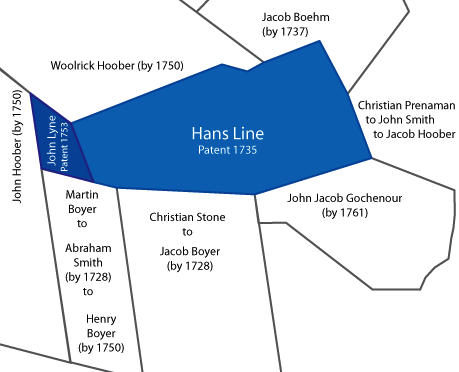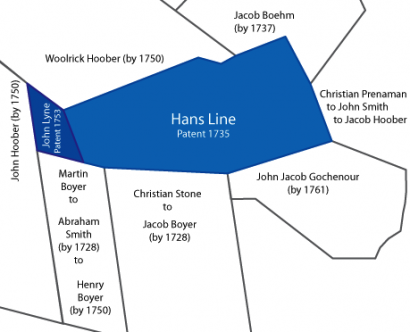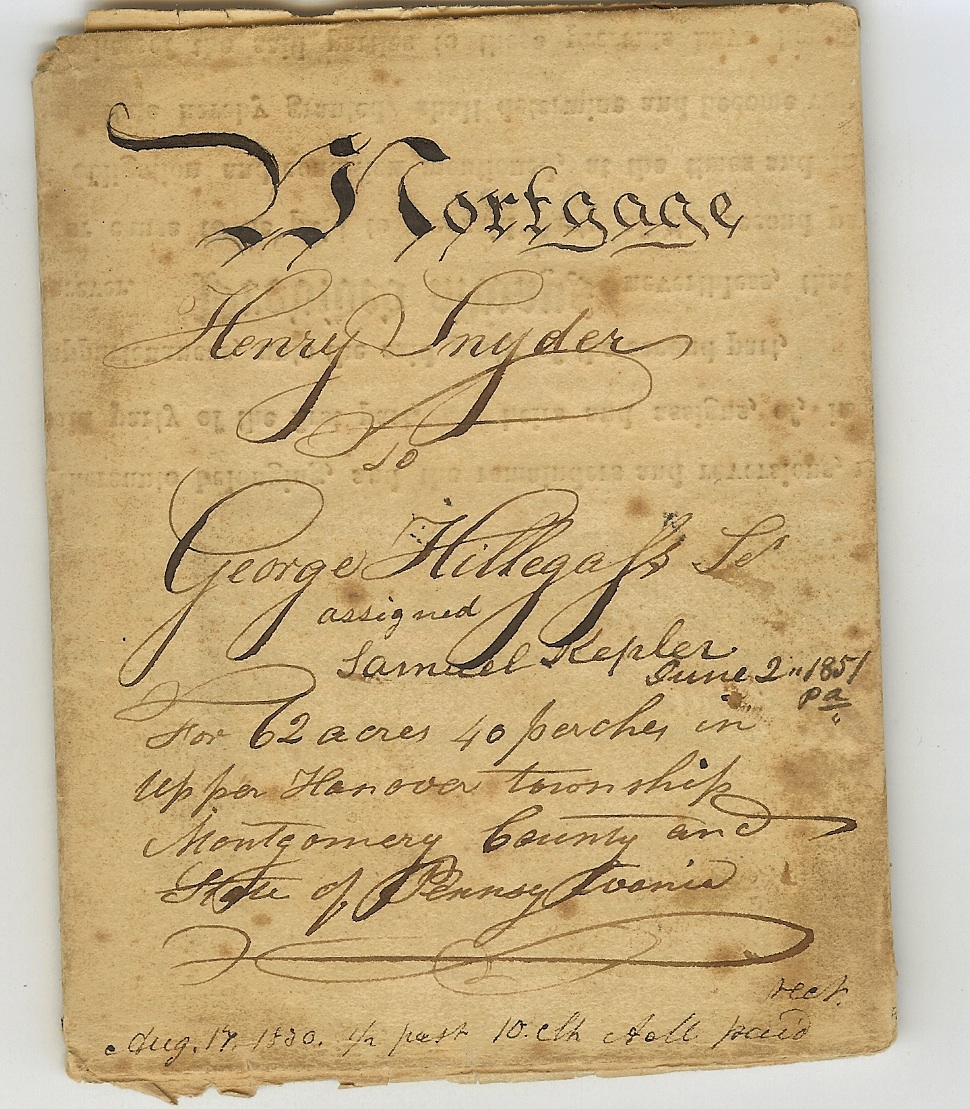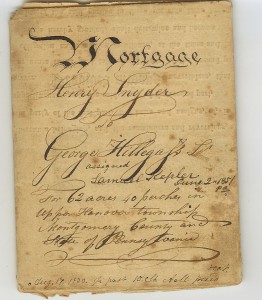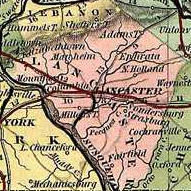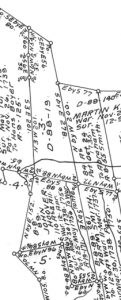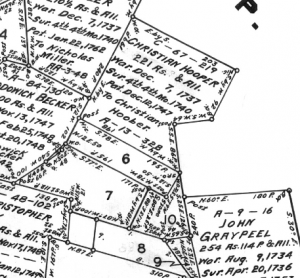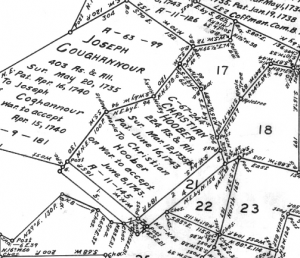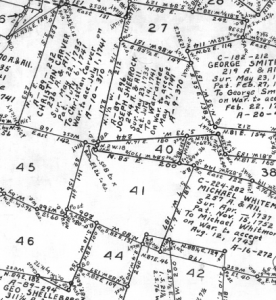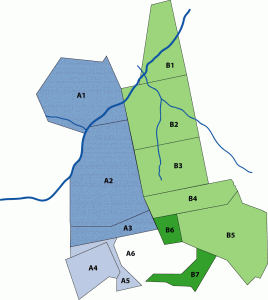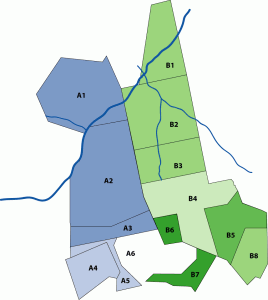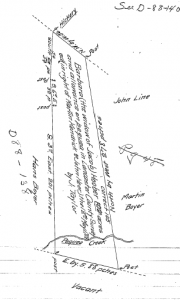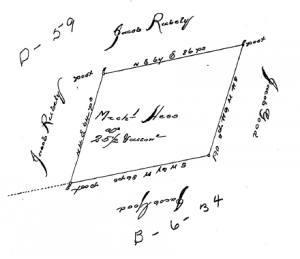Hans Line’s Conestoga Tract
On 22 November 1717, Martin Kendig (Kendick, Kendrick, Cundigg) and John Herr (Heer) were warranted 5,000 acres in Lancaster County by the Proprietaries of Pennsylvania. They, in turn, transferred this land to their fellow immigrants. Among these was Hans Line.
John Taylor surveyed 200 acres on a branch of Pequea Creek for Hans Line on 20 8ber [October] 1728 in right of Martin Kendig and John Herr.1 Adjoining landholders at the time of the survey included: Jacob Boyer (formerly Christian Stone), Abraham Smith (formerly Martin Boyer), and Christian Prenaman. Hans Line patented this tract on 14 April 1735.2 (See lighter blue section on map below.)
On 21 December 1750, John Line was warranted 23 1/2 acres, adjoining the 200 acre Hans Line tract.3 This tract was surveyed 23 December 1750 and patented to John Line on 9 April 1753.4,5 (See dark blue section on map above.) At the time of the survey, this tract adjoined land of Henry Boyer, Ulric “Hower” [Hoober], and John “Hower” [Hoober].
The following spring, on 24 March 1754, John Lyne and Barbara his wife sold 200 acres to John Lyne Jr.6 John Lyne Jr. was apparently the son of John and Barbara Lyne. The deeds where John Lyne [Jr.] transfers this land state “…the said John Lyne the father…did grant…unto the said John Lyne (party hereto) by the name John Lyne Jr…”
John Line Jr. apparently decided to retire from farming in 1785. On 8 Dec 1785, he divided the 200 acres his parents had sold him between Henry Line and Christian Line.7 (Refer to map above.) Neither of the deeds refers to John’s wife, nor did she sign either deed, indicating that she was already deceased.
Christian apparently took responsibility for caring for John Line as John sold him the additional 23 1/2 acres he’d patented in exchange for “good and decent boarding, washing, lodging, and apparel for him the said John Lyne Sr.” for the rest of his natural life. 8
According to the deed, Henry’s tract adjoined Jacob Boyers, Christian Brenneman, and John Lyne’s other property. However, by 1785 Jacob Boyer(s) had sold his adjoining tract to Jacob Boyers Jr.9 Jacob Boyers Jr., in turn, sold it in two tracts to Rudy Miller and Henry Boyers.10,11 The tract indicated for Christian Brenneman (if it’s the same as in the survey), was patented to Jacob Huber in 1759.12 He left it to his son Christian in his last will and testament.13 Christian then sold it to John Jacob Gochenour, whose heirs released it to his son Jacob in 1780.14
Christian’s adjacent neighbors were listed as Abraham Smith and Jacob Boyer. The transfers of Jacob Boyer’s property have already been mentioned. Abraham Smith’s tract, meanwhile, had passed to Henry Boyer by 1750.15 Henry Boyer’s heirs sold it to their new step-father Rudy Miller in 1776.16
John Line apparently passed away sometime shortly before 25 November 1805.17 The online will abstract lists as children: Henry, John, Jacob, Mary (wife of Jacob Warner), Ann (wife of Jacob Shallenberger), Christian, Abraham, Barbara (wife of Michael Shenk), and Elizabeth (wife of George Markley).18
On 21 July 1813, Christian and Feronica Line sold to their son Christian Jr. 23 acres two quarters nine perches, adjoining Henry Boyer, Henry Resh, the widow Brenneman and Christian Line Sr.19 This deed specifically outlines the passing of the land from John Line to his son John Line to his son Christian Line Sr. and then to his son Christian Line Jr., stating the tract was granted “…unto a certain John Line (Grandfather to the said Christian Line Senr.).”
Henry Line died sometime between 2 or 7 August 1815 and 11 November 1816.20 His property was passed on to his son John who sold five acres to Christian Hess on 16 April 1819.21 John is the only child mentioned in the will abstract. His wife is named as Anna, and his executors were Martin Funck and Henry Rush. Henry Rush was most likely a neighbor (see Christian Line’s deed above) and Martin Funck was most likely his brother-in-law. A deed pertaining to the settlement of a Martin Funk of Manor Township lists Anna, wife of Henry Line of Conestoga Township as his daughter and Martin Funck as his son (among others).22

